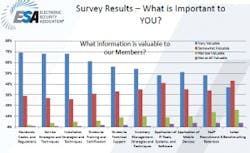Perhaps most effective would be to look at the non-traditional (or emerging) product categories that have impacted the security industry significantly just this past year.
Home automation, which many still believe to be a niche market, has played a heavy role in the developments of intrusion detection capabilities such as two-way voice communication; alarm panels that offer interactive features such as lighting or HVAC control; and even some intrusion providers offering apps that enable their users to view activities at their home remotely while away.
A need for more efficient energy management has caused many businesses and enterprises to re-evaluate where that additional money saved can be spent better elsewhere (flip back and read our full report from Schneider Electric's Editor's Day on page 10).
And most importantly, the Information Technology (IT) industry, which has a strong base in service level agreements and managed services, caused many traditional systems integrators and dealers to re-assess their skill sets to gain more installation and networking capabilities they need to offer services on a recurring basis (security integrators already know that sales from services provide more profit for them over an extended period of time versus a one-stop shop hardware installation).
And while there may be no one set way of defining what a non-security service is, many of its examples-training; internal or third-party monitoring; configuration and programming; remote business management; supply chain; identity theft and people counting-have already made their way into the industry beyond the traditional security offering.
"Newer technologies are a way for some of the smaller dealers to increase their revenue," said Mark Grossman, vice president, Branch Operations, ASG Security, Beltsville, Md. and chairman, ISP Group, Electronic Security Association (ESA). "To some of these companies, non-security categories are still foreign to them or perhaps they feel that they are too small to create a relationship with a provider of enhanced services."
Grossman added that the way these smaller companies can make the transition in offering non-traditional security services is through awareness, something which ESA's ISP Group is educating its members on.
"These enhanced services-controlling thermostats and lighting-are not that technologically advanced that it's above what the field-level folks are trained on today. It doesn't require this huge step where you need an engineer to identify how to make these systems work. I think it's just a fear of the unknown."
In fact, nearly 70 percent of ISP Group members surveyed agreed that they find information regarding service strategies and techniques and other installation strategies and techniques very valuable (see chart).
Trevor Block, vice president of Field Operations, Guardian Protection Services, Warrendale, Pa., and vice chairman, ISP Group, ESA agreed, adding that about 65 percent of the smaller dealer base is still in a "wait-and-see phase," and would prefer others to test the waters in offering non-security services or delving into non-traditional product categories. "But from conversations I have had at ESX and a dealer presentation in Chicago, 35 percent of those businesses are actively looking to pursue new products and look at different revenue streams."
Dealers and integrators need to continue to embrace services, including venturing into non-security specifications. Their role in tying both disparate security and non-security systems together depends on it if they are to grow with the times.
About the Author


